As the farm flourishes, so flourishes America
This year in Indiana spring sprang wet and stayed wet, delaying planting and improving habitat for mosquitoes. Ticks and fleas have flourished too. Corn, not so much. Nevertheless, Ron got the garden expanded and planted in good time; we don’t grow corn, but the okra was delayed. We’re harvesting greens (kale, turnip, mustard, and collards) aplenty and the tomatoes are fattening.

The garden May 17. Historically, the last frost in this part of Indiana averaged around May 15th, and it was safe to start planting. I put out seedlings and seeds May 1st.
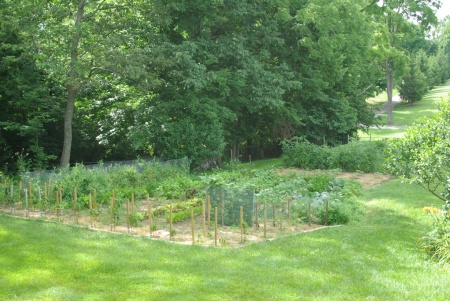
Same view of the upper main vegetable garden on June 27th. We have been harvesting lettuce, all kinds of greens, radishes, sugar snap and snow peas. We got the first ripe grape tomatoes this morning, and the tomatoes are dripping with large green tomatoes that will be ripening within a few days.
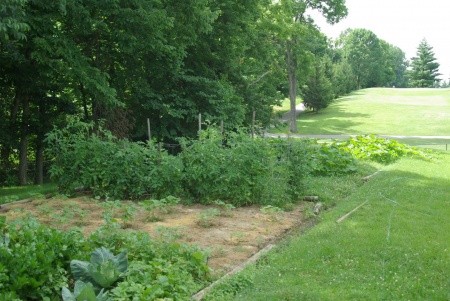
This is view of lower end of garden with tomatoes, with the two strips in the background for summer squash, zucchini, acorn squash, and pumpkins. We also planted some watermelon and cantelope, and it will be interesting to see if they do anything.
Recently, we visited friends in northern Indiana for a wonderful weekend of food and fun. There, in the heart of Amish and Mennonite country, we enjoyed watching buggies drive by our friends’ old farmhouse and learning more about the various Anabaptist denominations and cultures. A neighboring farmer allowed us to watch the evening milking of his large herd of Holsteins and told us about the plight of family farmers and dairy farming. Such families are real heroes in the old-time American mold; yet, to great extent, our nation has lost its awareness of and appreciation for their contributions to our food supply and well-being.

Dairy cows lines up to be milked in barn. This operation has capacity to accumulate 1,000 gallons at a time for pickup by semi that delivers to milk processing facilities.
In talking with many of our friends, we have discovered that we are not the only ones in our circle who are turning more and more to organic and locally produced foods. For a number of years we have been members of our outstanding local co-op, Bloomingfoods, where such foods and other environmentally sound products can be purchased. We are so lucky to have this grass-roots store, with its three convenient locations. But demand by people everywhere has made the national grocery stores carry more and more organic products, from produce to dairy to eggs and meat. Even as this trend gains momentum, we wonder whether it is happening in time. So much damage has been wrought over past decades. Still, as Pollyanna says, better late than never.

Salmon croquettes with fresh parsley from the early herb garden.
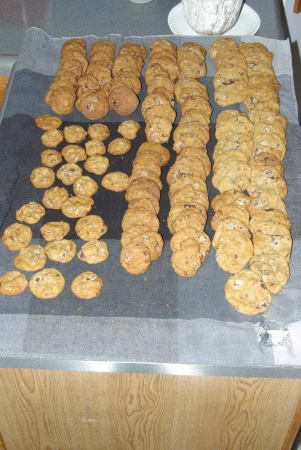
Homemade chocolate chip pecan cookies, fresh out of the oven.
On another note, while in northern Indiana, we stopped at the Studebaker Museum in South Bend, Ind., to see some American automotive history up close. The museum is quite interesting and complete, tracing the Studebaker family’s vehicular involvement through the generations and including period accessories in each display to give a broader picture of American history. An unexpected display was Abraham Lincoln’s last official carriage, which awed us to stand in the presence of that great president’s primary transportation. It was the one he and Mary rode in to Ford’s Theater.
We also got to see closeup and personal an original condition 1938 Cadillac. It is in original condition, with only a few minor blemishes on the paint. Even the original intercom in the rear of the car still works, so the executive seated there can communicate with the driver even if the glass partition between the driver’s seat and the rear of the car is raised.
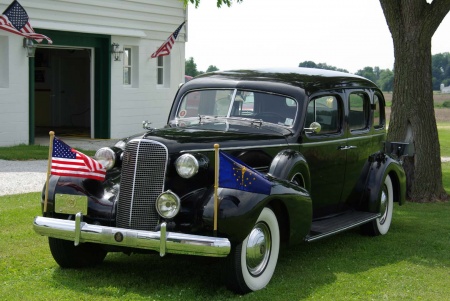
This is the Cadillac parked in front of our host’s barn, with soy and corn fields in the background.
We also visited the Grissom Air Museum near Peru, Ind., to see the extensive display of airplanes (outside) and memorabilia from past Air Force engagements (inside). Human engineering feats amaze us! At this point in human history, we felt the weight of the times we have lived through so far, from the mid-20th century to the early-21st century, and fervently hoped that such machines and their fuels will soon be replaced by greener and more peaceful technology.
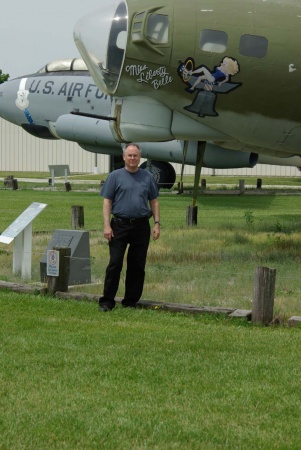
Ron by WWII B-17G Flying Fortress “Miss Liberty Bell” bomber with traditional painted figure.
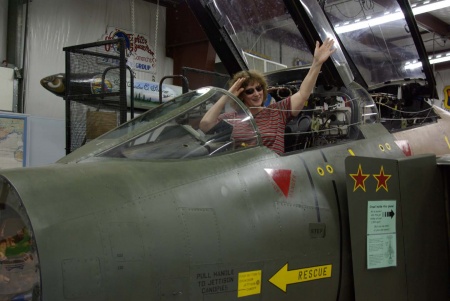
Carol in cockpit of F-4C fighter in the museum.